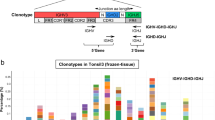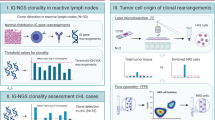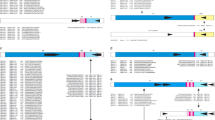Abstract
The development of rapid polymerase chain reaction (PCR) protocols for amplification of rearranged heavy chain immunoglobulin (IgH) gene sequences has facilitated the identification of clonal IgH rearrangements in non-Hodgkin’s lymphomas (NHL) and leukemias of B lineage. In the present report we have explored the recently described improved strategy for assessment of clonality of rearranged immunoglobulin heavy chain (IgH) genes in more detail in a series of 101 B cell malignancies and 50 polyclonal controls. The assay is based on an IgH-PCR with an automated fluorescence-based strategy for PCR detection of IgH gene rearrangements. Third complementarity determining region (IgH-CDR3) sequences were amplified using fluorescent dye labeled consensus primers homologous to the corresponding variable (VH) and joining (JH) gene segments in combination with a thermostable proofreading DNA polymerase. PCR products were size separated on a high resolution polyacrylamide gel and analyzed for clonality by exact size determination and fluorescence quantification in an automated DNA sequencer. PCR findings obtained with the optimized IgH-CDR3-PCR assay showed an overall monoclonality detection rate of 97% (97 of 101 cases with B cell neoplasms). The specificity was 100% as determined by analysis of 50 controls, all of which gave polyclonal PCR results. We found a high rate of monoclonal IgH-CDR3-PCR results not only in the leukemias and diffuse lymphoma but also in the group of follicular lymphoma, where a high rate of false negative results is frequently reported in the literature. In summary, we identified monoclonal IgH-CDR3 junctions in 55 out of 59 cases (93%) with B cell lymphoma and in 42 of 42 (100%) cases with leukemia, immunocytoma and multiple myeloma. The results demonstrate that automated fluorescence detection of IgH-CDR3-PCR products is an ideal tool for detection of clonal and polyclonal lymphoid B cells. In combination with allele-specific primers the procedure may improve current experimental approaches to detect occult malginant B cells during initial staging and follow-up of NHL and ALL patients.
This is a preview of subscription content, access via your institution
Access options
Subscribe to this journal
Receive 12 print issues and online access
$259.00 per year
only $21.58 per issue
Buy this article
- Purchase on Springer Link
- Instant access to full article PDF
Prices may be subject to local taxes which are calculated during checkout
Similar content being viewed by others
Author information
Authors and Affiliations
Rights and permissions
About this article
Cite this article
Linke, B., Bolz, I., Fayyazi, A. et al. Automated high resolution PCR fragment analysis for identification of clonally rearranged immunoglobulin heavy chain genes. Leukemia 11, 1055–1062 (1997). https://doi.org/10.1038/sj.leu.2400736
Received:
Accepted:
Issue Date:
DOI: https://doi.org/10.1038/sj.leu.2400736
Keywords
This article is cited by
-
Clinical utility of recently identified diagnostic, prognostic, and predictive molecular biomarkers in mature B-cell neoplasms
Modern Pathology (2017)
-
Nodal Relapse After Helicobacter pylori Eradication in a Patient With Primary Localized Gastric Mucosa-Associated Lymphoid Tissue Lymphoma
American Journal of Gastroenterology (2011)
-
In angioimmunoblastic T-cell lymphoma, neoplastic T cells may be a minor cell population. A molecular single-cell and immunohistochemical study
Virchows Archiv (2005)
-
Rearranged T-cell receptor beta genes represent powerful targets for quantification of minimal residual disease in childhood and adult T-cell acute lymphoblastic leukemia
Leukemia (2004)
-
Comparative analysis of minimal residual disease detection using four-color flow cytometry, consensus IgH-PCR, and quantitative IgH PCR in CLL after allogeneic and autologous stem cell transplantation
Leukemia (2004)



